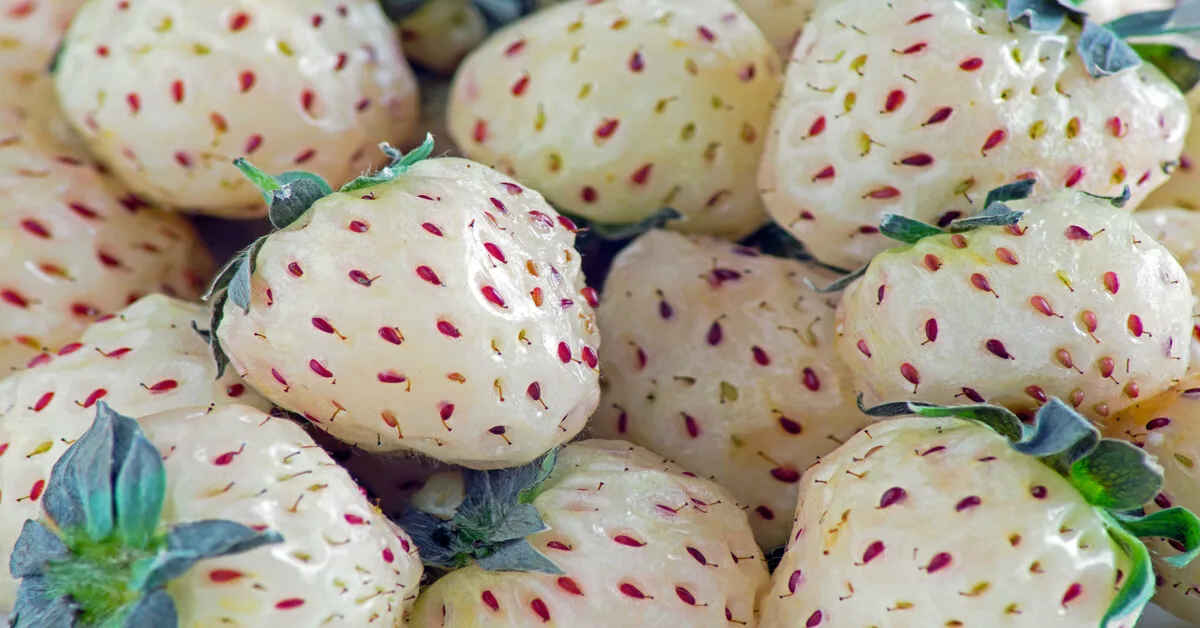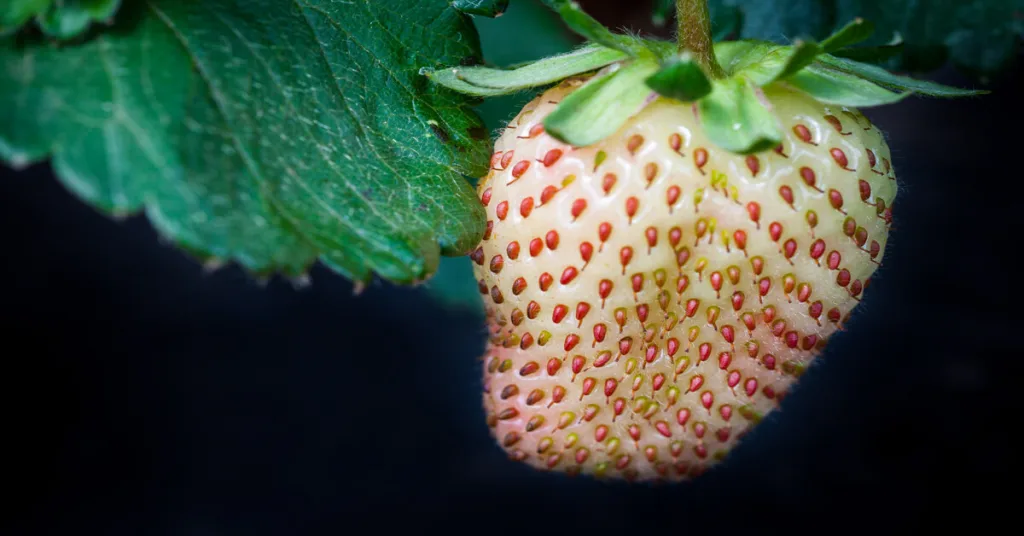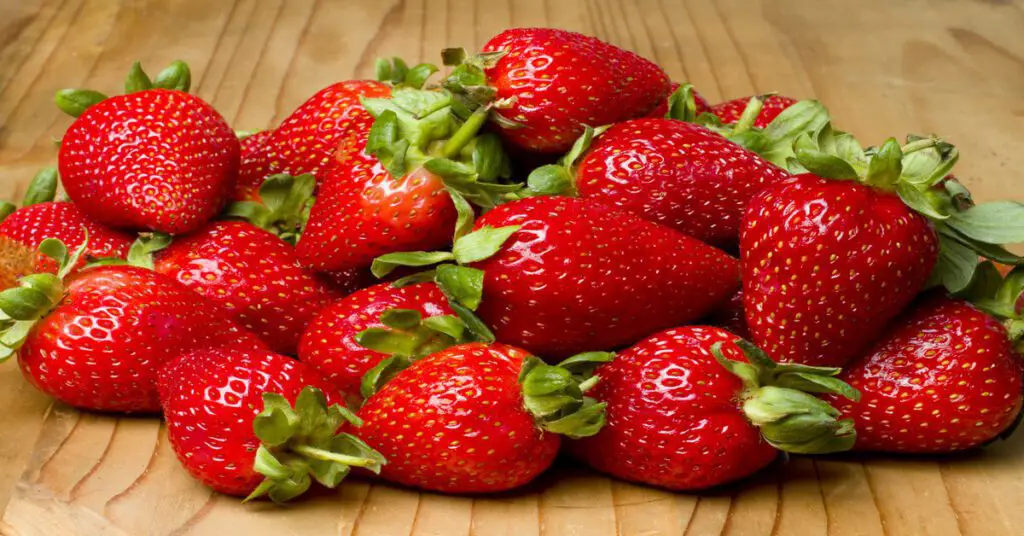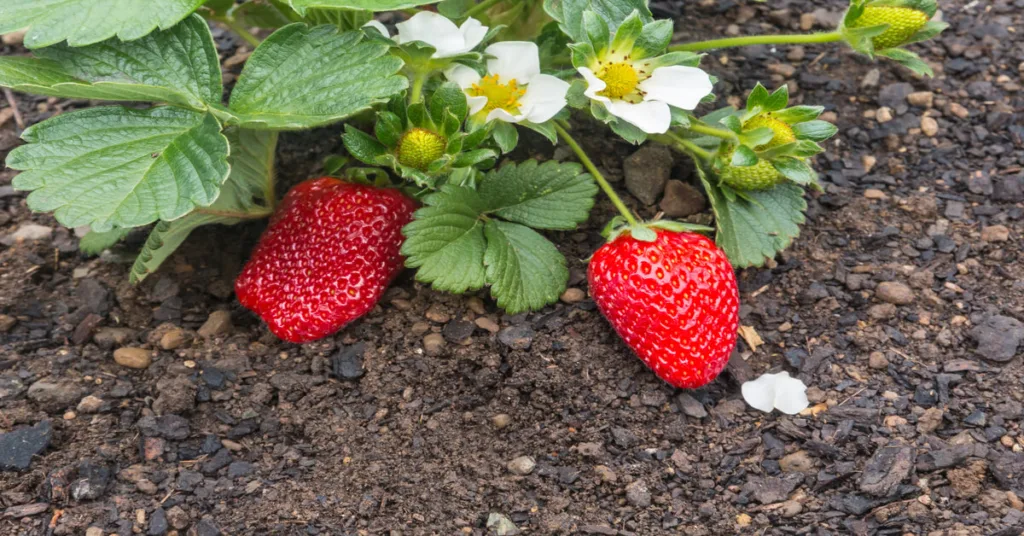Some of the links in this post are affiliate links. This means if you click on the link and purchase the item, I will receive an affiliate commission at no extra cost to you.
If you’re a fan of strawberries, you’ll want to give white alpine strawberries (Fragaria vesca) a try.
Unlike red strawberries, white alpine strawberries are much rarer and often more expensive due to their unique appearance and delicate flavor.
Native to the European Alps, white alpine strawberries have been enjoyed for centuries and have recently gained popularity in the United States.
If you’re looking to add something new and exciting to your fruit repertoire, give white alpine strawberries a try. You won’t be disappointed!
What are White Strawberries?
White alpine strawberry plants are highly sought-after natural mutations of the wild woodland strawberry (Fragaria vesca), also known as Fraises des Bois, wild strawberries, or woodland strawberries.
White alpine strawberries are not typically grown commercially as they are too little and fragile for transport or even farmers’ markets.
However, these small herbaceous perennial plants can be grown as ornamentals as well as for their attractive and small tasty fruit.
The red-seeded white fruits of white alpine strawberries are prized for their sweet, juicy flesh, creamy color, and intense aroma, which is often described as being reminiscent of pineapple, vanilla, or rose petals.
Why are White Strawberries White?
White alpine strawberries are white because they have a genetic mutation that results in a lower amount of anthocyanin, the pigment which gives regular strawberries their red color.
White strawberries are also often grown in shaded areas, which reduces the amount of sunlight they receive. In plants, exposure to sunlight also triggers the production of anthocyanin.
White Strawberry Plant Care
White alpine strawberries do not produce runners or vines, so they grow quite compact, topping out at 10-12 inches (25-30 cm) high and wide.
Fruits are typically 0.5-1.2 inches (1-3 cm) or less and cone-shaped, but are intensely aromatic and delicious.
The small-size, flavor, and shade tolerance of white alpine strawberries make them great for container pots, baskets, or window boxes.
They are also perfect for cooler areas such as along a woodland path or on a windowsill.
Soil
White alpine strawberries prefer well-draining soil that is rich in organic matter. They do not tolerate waterlogged soil, so choose a location that has good drainage.
If your soil is heavy or clay-like, you may need to amend it with organic matter such as compost or peat moss to improve its drainage and fertility.
Additionally, white alpine strawberries prefer a slightly acidic soil pH of around 6.0 to 6.5.
If you are unsure about the pH of your soil, you can test it with a soil pH test kit from a garden center or nursery.
Watering
Water white alpine strawberries with ~1-2 inches (2.5-5 cm) once or twice a week. Water deeply and less frequently to keep the soil moist, but not waterlogged.
Overwatering may cause stress and lead to root rot. Avoid getting leaves wet to prevent the growth of fungal diseases.
Lighting
White alpine strawberries prefer a location with plenty of indirect sunlight (4-6 hours). They do not tolerate full shade, but they also do not do well in direct, intense sunlight.
A location with dappled sunlight or partial shade, with some protection from the midday sun, is ideal.
Humidity & Temperature
Alpine strawberries are frost-hardy plants that can withstand a variety of temperatures, though they do best in cool to moderate temperatures between 60-75°F (15-24°C).
The ideal relative humidity is between 65-75%, though alpine strawberries will tolerate a wide range of humidities that aren’t extremes on either end.
Fertilizing (NPK)
In general, strawberries require a well-balanced supply of all three NPK nutrients, with 1 pound (0.45 kg) of 5-5-5, 10-10-10, or 13-13-13 NPK fertilizer applied for every 10 linear feet (3 m) of strawberry plants.
Organic farmers can use water-soluble plant fertilizers such as fish emulsion, kelp, cottonseed meal, bone meal, seaweed, etc.
Propagating
Alpine strawberries don’t typically produce runners like regular strawberries. They grow compact and in clumps, so it’s best to propagate by crown division.
To propagate alpine strawberries by division, start by carefully digging up the crown of a mature alpine strawberry plant. The crown is the central part of the plant where the roots and leaves meet.
Once you have the crown, divide it into several smaller pieces, each with a few roots and leaves.
Plant the crown pieces in well-draining soil, and provide plenty of moisture and light to encourage growth. The crowns should develop into new alpine strawberry plants within a few weeks.
Diseases & Pests
White alpine strawberries are said to be more disease and pest-resistant than regular strawberries, but they can still be affected by various strawberry diseases and pests.
Some common diseases that affect alpine strawberries include verticillium wilt, leaf spot, gray mold, powdery mildew, and anthracnose.
Pests that may affect wild strawberries include slugs, aphids, thrips, crown bores, white flies, and strawberry root weevils.
To control diseases and pests, it is important to practice good growing techniques, such as proper watering (avoid getting leaves wet) and spacing of plants (space plants at least 12-18 inches or 30-45 cm apart to ensure adequate airflow).
Pests and diseases can generally be controlled with a fungicide or insecticide.
Days to maturity
The days to maturity for white alpine strawberries can vary depending on the specific variety and growing conditions. In general, white alpine strawberries are relatively fast-growing and take 70-120 days after planting to bear mature fruit.
Pruning
Alpine strawberries tend to grow compact and do not produce runners, so they generally require little pruning.
However, damaged or diseased leaves and stems can be pruned to promote healthy growth and fruit production.
Hardiness Zones
Alpine strawberries are adapted to a wide variety of climates and soils. In general, they are best suited for growing in USDA hardiness zones 3-10. [1]
Types of White Strawberries

White alpine strawberries (Fragaria vesca) are one of several species of white strawberries.
Some of the more common distinct white strawberry species include:
- Fragaria vesca, also known as wild strawberry, woodland strawberry, Fraiser des Bois, and alpine strawberries, have natural mutations that also produce white strawberries. Popular cultivars include White Soul, White Delight, White Solemacher, Ivory, Golden Alpine, and Pineapple Crush.
- Fragaria chiloensis, also known as the beach, coastal, or South American strawberry, is another species of white strawberries known for their large, aromatic, and sweet fruits. Native to Chile, these plants bear larger strawberries and are usually more tolerant of salty soils.
- White pineberries (Fragaria ananassa) are a hybrid cross of Fragaria chiloensis and Fragaria virginiana and are known for producing small, pale green or white strawberries with a pineapple flavor and aroma. Popular white pineberry cultivars include White Pine, White D, White Carolina, and Natural Albino.
What do White Strawberries taste like?
White alpine strawberries are often described as having a delicate, floral flavor that is both sweet and slightly tart. The fruit has a tender, juicy texture and a unique aroma that sets it apart from other strawberry varieties.
Some people describe the flavor of white alpine strawberries as being similar to a mix of strawberry, honey, and vanilla, with a slight tanginess that adds depth and complexity to the flavor.
Where to buy White Strawberry seeds
White alpine strawberry seeds can occasionally be found at garden centers, seed exchanges, or even online on sites such as Rareseeds and Urbanfarmer.
White Strawberry vs Pineberry
The main difference between a white alpine strawberry and a pineberry is in color, flavor, and size. Pineberries (a hybrid cross of Fragaria chiloensis and Fragaria virginiana) are pale green or white when ripe, have a pineapple-like flavor and aroma, and are even smaller than white alpine strawberries.
References:
[1] Pettinelli, D. (n.d.). Alpine Strawberries – Small Size, Big Taste. University of Connecticut Home and Garden Education Center. Retrieved December 13, 2022, from https://blog.extension.uconn.edu/wp-content/uploads/sites/419/2020/07/Alpine-Strawberries_.pdf.



